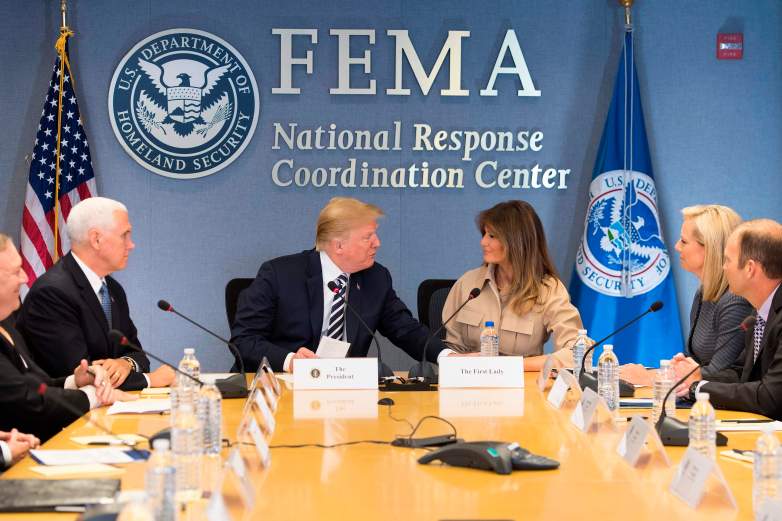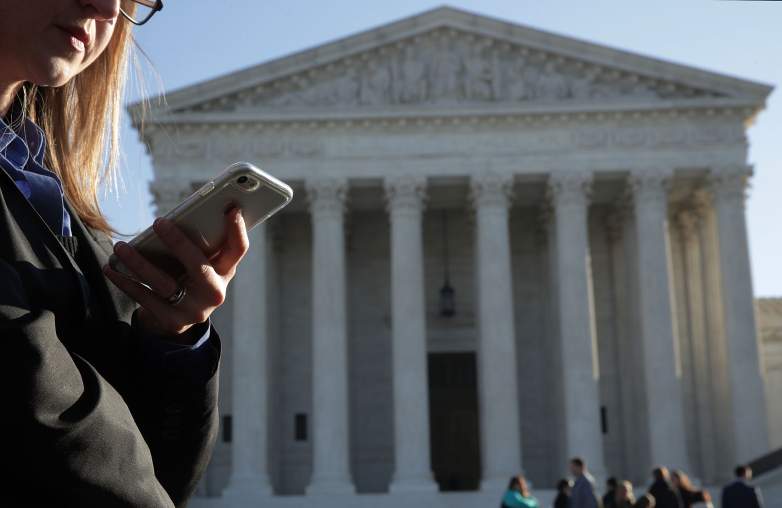
Getty A customer inspects an iPhone.
Almost every person in the United States who has a cell phone is going to receive a Presidential Alert on Wednesday. The WEA text message will be sent at 2:18 p.m. Eastern (1:18 p.m. Central) and the EAS message will be sent two minutes later, at 2:20 p.m. Eastern. This is being sent by FEMA, in coordination with the FCC, the Emergency Alert System, and Wireless Emergency Alert. Here is everything you need to know about the Presidential Alert.
1. This Is the First Nationwide Presidential Alert Test & the Fourth National EAS Test
The message being sent today is just a test and not an actual alert. It’s the first national Presidential Alert test, which will allow any sitting President to send nationwide emergency messages.
This will also just be the fourth time that a nationwide EAS alert has been tested. The first three were November 2011, September 2016, and September 2017, Accuweather reported. This is the first national WEA test.
And no, you can’t turn off the Presidential Alert.
The EAS test will be sent at 2:20 p.m. Eastern and the WEA test is being sent at 2:18 p.m. Eastern. Cell towers will broadcast the WEA test for about 30 minutes and the EAS test will last for about a minute. Only phones that are WEA compatible, turned on, and within range of an active cell tower will actually get the message. A wireless provider must also be participating in the WEA in order to receive the test message, Accuweather reported.
2. The WEA System Warns Mobile Phone Users About Dangerous Weather, Missing Children & Additional Critical Information
The National Wireless Emergency Alert System (WEA) is typically used to warn the public about missing children, dangerous weather, and other critical information via cell phone alerts.
The WEA message will read: “Presidential Alert. THIS IS A TEST of the National Wireless Emergency Alert System. No action is needed.”
The test is allowing FEMA to assess “the operational readiness of the infrastructure for distribution of a national message to determine whether improvements are needed.”
FEMA has said that the alert isn’t an actual text or SMS (so you won’t be charged for this.) Instead, it’s an audio and text warning that works similarly to the AMBER alerts and weather emergency notices that you might receive. The main difference is that this is nationwide rather than regional.
3. The EAS Presidential Alert Is Being Sent Over Broadcast TV & Radio
The EAS test message is a nationwide emergency alert test that is sent out on broadcast television and radio, rather than on mobile phones. You’re probably familiar with this system because it’s been around for a long time. This test will look and feel similar to the monthly EAS tests sent out on TV and radio, and it will interrupt whatever you’re watching for about a minute.
The EAS Presidential Alert will read: “THIS IS A TEST of the National Emergency Alert System. This system was developed by broadcast and cable operators in voluntary cooperation with the Federal Emergency Management Agency, the Federal Communications Commission, and local authorities to keep you informed in the event of an emergency. If this had been an actual emergency, an official message would have followed the tone alert you heard at the start of this message. A similar Wireless Emergency Alert test message has been sent to all cell phones nationwide. Some cell phones will receive the message; others will not. No action is required.”
The Emergency Alert System (EAS) is a national warning system that requires participants to provide the President with the ability to address the nation during a national emergency. It can also be used regionally for emergency information like AMBER alerts.
4. Some People Are Suing To Try to Stop Presidential Alerts
Manhattan plaintiffs are suing President Donald Trump and FEMA Administrator Brock Long. They allege that the Presidential Alert is a violation of the First and Fourth Amendment, not allowing Americans to be free of government-compelled listening, and amounts to a seizure of their cellular devices and a warrantless trespass, CBS News reported. They say the system is essentially hijacking private property to create a government-controlled loudspeaker “in the home and on the person of every American.”
You can read the full complaint here. Essentially, plaintiffs are concerned that because President Donald Trump consistently “disseminates … politically biased messages” they worry the same thing will happen with the alerts.
5. The Presidential Alert Should Only Be Used to Warn About Impending Crises & Not for Political Messages
Jeh Johnson, Homeland Security chief, told CBS This Morning that the alert is only used for “true emergencies when we need to get the public’s attention.” It’s not supposed to be used for political purposes, and it will only be used very rarely. The political purposes point is especially important, he noted, since people cannot opt out of the presidential alert. There are laws in place and protocols that make sure the use is in accordance with the law, he emphasized.
The WEA system currently only supports English messages at this time, FEMA noted. FEMA is exploring making the alerts available in additional languages.
You will not be charged for this message, the alerts do not collect any data, and the alerts do not have any tracking capabilities.


